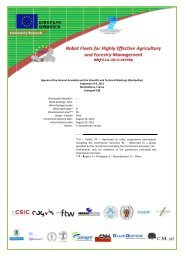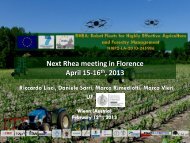1st Workshop BOOK - project RHEA
1st Workshop BOOK - project RHEA
1st Workshop BOOK - project RHEA
Create successful ePaper yourself
Turn your PDF publications into a flip-book with our unique Google optimized e-Paper software.
2. Step 1: Field inspection<br />
Robotics and associated High technologies and Equipment for Agriculture<br />
Information on weed spatial distribution and abundance will be generated from<br />
aerial images obtained at different times prior to herbicide spraying and from<br />
information obtained from ground vehicles at spraying time. Aerial inspection of<br />
the fields in spring, when some broadleaved weeds are in full bloom (and can be<br />
easily discriminated from the crop) provide an excellent opportunity to<br />
discriminate and map infestations of selected weed species. Numerous studies<br />
have shown that detection of late-season weed infestation has considerable<br />
possibilities when the weeds exceed the crop canopy and the spectral differences<br />
between crops and weeds are maximum (López-Granados, 2011). Detection of<br />
bright coloured red poppies (Papaver rhoeas) on the green background provided by<br />
the crop may be a paradigmatic example of this situation. Monitoring weed<br />
populations at various times will be achieved using unmanned aerial vehicles<br />
(UAV). These vehicles provide high spectral, spatial and temporal resolutions with a<br />
relatively low cost (López-Granados, 2011). Additional georeferenced data on weed<br />
infestations will be obtained at spraying time by the cameras or sensors located on<br />
the sprayers (Andújar et al., 2011; Burgos-Artizzu et al., 2011).<br />
3. Step 2: Long-term decisions<br />
Farmers usually consider two different time-scales for decision making: long term<br />
(with a 3-5 year horizon) and current year. Consequently, a comprehensive system<br />
should include a long-term planning tool allowing users to consider various cultural<br />
practices (rotations, tillage systems) conducted over several years and a within<br />
season planning tool to investigate a range of weed control options in a single<br />
season (Parsons et al., 2009).<br />
The objective of the our long-term decision module is to optimize the choice of<br />
crop and herbicide rotations as well as the tillage system throughout a rotation (up<br />
to 5 years) defined by the user, trying to find the best long-term strategy. The<br />
decision process could be made using a finite horizon stochastic dynamic program,<br />
trying to identify the policy that maximizes the long term expected discounted<br />
return. Other option could be using a set of decision rules coupled with a rule<br />
editor and an inference engine. In order to take these decisions, different types of<br />
data are required.<br />
Historic maps, constructed using the weed distribution data obtained in the<br />
previous step, provide one major element for this process. In addition, empirical<br />
knowledge of the farmer, gathered through many years of working the field, is also<br />
a valuable data source that should be exploited, particularly when digital maps with<br />
historical records are not available. All this information is stored in a `Weed spatial´<br />
database.<br />
Biological data on the major weeds that are present in the field are required to<br />
assess the actual risks posed by those plants and the opportunities and possibilities<br />
5




